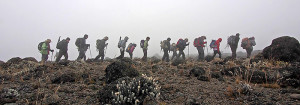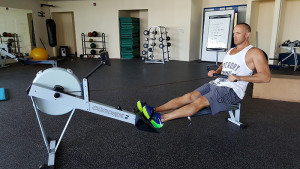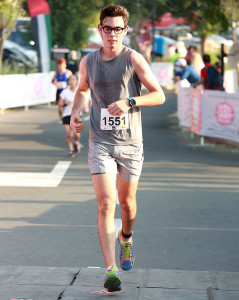Act 2: Ego
45% of all climbers make it to the summit of Mt Kilimanjaro. It’s true. That’s the published figure by Kilimanjaro National Park although companies publish their figures at 75%. The catch? An altitude of 5,985 metres and a horizontal distance of 70 kilometres to cover with our group having as much accrued acclimatization as a stranded fish.
So the question dominating all thoughts in anticipation of our impending expedition to the roof of Africa is how do we make it to the top and not embarrass ourselves? Being carried off by fit mountain rangers, past an assembled team of guides and porters sniggering at another team of wazungukichaa, that failed to heed their expert advice of “pole pole” or “slowly slowly” makes it very difficult to keep your upper lip stiff.
And this is the brunt of the Kili problem. Ego. In the mix is the heady whiff of testosterone from four males that enjoy different physical disciplines. We also don’t know each other well enough to have any established pecking order. What could possibly go wrong? Ego and competition are probably the most likely causes of failed expeditions the world over and give Kilimanjaro that added excitement factor.
It’s not just exuberance and healthy competition that jeopardises any or all that will ascend in this jolly foursome. Oh no, it’s the steady accumulation of know-it-all friends and family that mention some octogenarian Kili summiteer or chain-smoking amorphous lump that has returned to bask in their richly deserving praise. All of these triumphs are wonderful accounts of success in the face of adversity that weigh heavily on the shoulders of our group seeking to follow in their footsteps. And thus compound the desire to avoid the condescending post climb comments of: “but you did your best,” or the glib “there’s always a next time,” that accompanies any spectacular physical collapse. Just ask Jordan Spieth about his performance at the recent Golf Masters. I am sure he heard all of the above, but in his mind he choked — impressively.
As a general rule, collective wisdom suggests that an organized and committed fitness program triumphs shawarmas and shisha in preparation. So a little pre-expedition training may go a long way to
improving our post Kilimanjaro dinner conversation. “I did it- the top was sublime” carries more punch than having to mutter, “I didn’t make it,” quietly, and then having to explain the details of being carried off,
gibbering like a lunatic.
Success should also help placate our generous sponsors who have so far contributed 20,000 dirhams of the targeted 50,000 dirhams (More donations gratefully received). Sancho and Michele will spend ten days at the orphanage working alongside the staff their teaching and helping out with the projects.
Planning for fitness training often suffers from the sense that more complicated and technical is better than simple. We generally go for smarter phones and more complicated cars so why not apply that logic to exercise? As a group we have thoroughly endorsed this by making our training as diverse and difficult as possible, despite going on what is essentially a long and steep walk.
Sancho, at seventeen and with the boundless energy of a youthful triathlete, is following a particularly gruelling schedule. His training is weekly and involves:
Sunday: 1km early morning swim
Tuesday: 10km early morning run around Arabian Ranches
Wednesday: 50km bike ride at the Dubai Autodrome
Friday: 30km mountain biking in the Hajar Mountains at Hatta or Wadi Showka
Saturday: 65km bike ride around the Al Qudra loop.
Neil, a product of the 70’s, will follow a more traditional upper body gym-based program for two days, attend circuit sessions once, and flog himself through the summer heat in and around the Marina for two 10km runs per week. The plan for Neil is to up this in July in preparation for the start of our climb on the 2nd of August, 2016. As the oldest, and with the greatest physical wear and tear, I have thrown myself with renewed vigor at Freeletics gym with lots of rowing for good measure. The aim for all is to improve our VO2 max whilst also developing our leg and core strength.
So that’s sorted then and this is our guide on how best to approach climbing Mount Kilimanjaro; I am planning on burpeeing and rowing my way to the top, Sancho and Michele will swim and cycle and Neil will have to do it on his hands.
Realistically what we should do is clearly much more simple – practise walking, preferably on hills, a lot.
The Kili Quartet is composed of Geography teacher Ben Thompson, students Sancho Barcia and Michele Longhi and Neil Davies on a quest to climb the highest freestanding mountain in the world.
Their journey sees them preparing for the fateful climb as a group of friends for the cause of helping children in Tanzania as well as teaching them math and English.
To support their cause visit www.crowdfunder.co.uk/upendo-childrens-home-fund-raiser or follow the climb at www.facebook.com/uchkiliclimb
Words by: Ben Thomas
Photos Supplied by: Sancho Barcia




